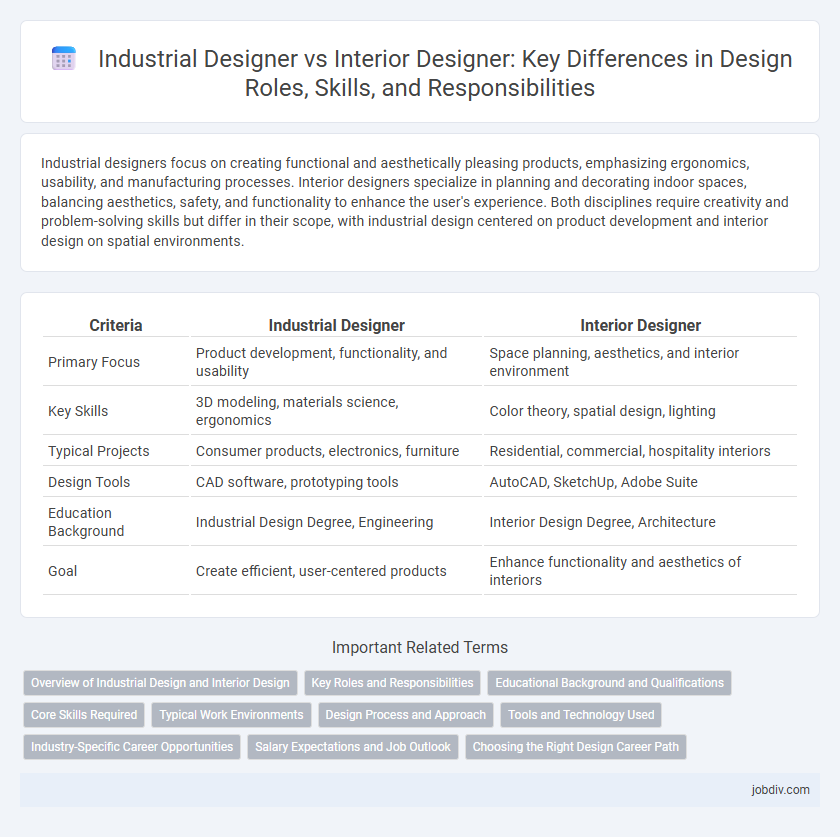Industrial designers focus on creating functional and aesthetically pleasing products, emphasizing ergonomics, usability, and manufacturing processes. Interior designers specialize in planning and decorating indoor spaces, balancing aesthetics, safety, and functionality to enhance the user's experience. Both disciplines require creativity and problem-solving skills but differ in their scope, with industrial design centered on product development and interior design on spatial environments.
Table of Comparison
| Criteria | Industrial Designer | Interior Designer |
|---|---|---|
| Primary Focus | Product development, functionality, and usability | Space planning, aesthetics, and interior environment |
| Key Skills | 3D modeling, materials science, ergonomics | Color theory, spatial design, lighting |
| Typical Projects | Consumer products, electronics, furniture | Residential, commercial, hospitality interiors |
| Design Tools | CAD software, prototyping tools | AutoCAD, SketchUp, Adobe Suite |
| Education Background | Industrial Design Degree, Engineering | Interior Design Degree, Architecture |
| Goal | Create efficient, user-centered products | Enhance functionality and aesthetics of interiors |
Overview of Industrial Design and Interior Design
Industrial design centers on creating and developing concepts for manufactured products, emphasizing functionality, usability, and aesthetics to enhance consumer experience. Interior design focuses on optimizing indoor spaces for comfort, safety, and visual appeal by integrating architectural elements, furnishings, and lighting. Both fields blend creativity with technical knowledge but differ in their primary objects of design--products versus environments.
Key Roles and Responsibilities
Industrial designers focus on creating functional and aesthetically pleasing products by combining art, engineering, and user experience principles, emphasizing ergonomics, materials, and manufacturing processes. Interior designers concentrate on designing interior spaces to optimize functionality, safety, and visual appeal, integrating elements like color schemes, furniture layout, lighting, and spatial planning. Both roles require collaboration with clients and stakeholders, but industrial designers typically work on product development while interior designers focus on enhancing built environments.
Educational Background and Qualifications
Industrial designers typically possess a degree in industrial design, product design, or engineering, emphasizing technical skills, materials science, and manufacturing processes. Interior designers usually hold a degree in interior design or architecture, focusing on spatial planning, aesthetics, and building codes. Both require proficiency in design software and often seek professional certification such as NCIDQ for interior designers or IDSA membership for industrial designers.
Core Skills Required
Industrial designers excel in product development, emphasizing skills in 3D modeling, prototyping, and materials engineering to create functional and aesthetically pleasing objects. Interior designers prioritize space planning, color theory, and knowledge of building codes to enhance interior environments for safety, comfort, and visual appeal. Both roles demand strong creativity, problem-solving abilities, and proficiency in design software specific to their disciplines.
Typical Work Environments
Industrial designers typically work in product development firms, manufacturing companies, or design studios where they focus on creating functional and aesthetic products. Interior designers usually operate in architectural firms, residential or commercial design agencies, and client spaces, emphasizing spatial planning and ambiance enhancement. Both professions demand collaboration but differ significantly in their primary settings and project scopes.
Design Process and Approach
Industrial designers focus on creating functional and aesthetically pleasing products through iterative prototyping, user research, and material analysis, emphasizing ergonomics and manufacturing feasibility. Interior designers prioritize spatial planning, color theory, and ambiance to enhance livability and aesthetic appeal within buildings, often collaborating with architects and contractors. Both disciplines apply problem-solving and creativity but differ in scope, with industrial design centered on product development and interior design focused on environment optimization.
Tools and Technology Used
Industrial designers primarily use CAD software such as SolidWorks and Rhino to create detailed product models and prototypes, alongside 3D printing for rapid prototyping. Interior designers rely on tools like AutoCAD, SketchUp, and Revit for space planning, 3D visualization, and rendering to finalize interior layouts and aesthetics. Both disciplines leverage virtual reality (VR) and augmented reality (AR) technologies to enhance client presentations and streamline design decision-making processes.
Industry-Specific Career Opportunities
Industrial designers specialize in creating innovative products for manufacturing, focusing on functionality, ergonomics, and mass production across industries such as automotive, consumer electronics, and medical devices. Interior designers concentrate on optimizing spatial aesthetics and functionality in residential, commercial, and hospitality sectors, tailoring environments to client needs and regulatory standards. Career opportunities for industrial designers often involve product development and innovation in factories and design firms, while interior designers find roles in architectural studios, real estate, and specialized interior design agencies.
Salary Expectations and Job Outlook
Industrial designers typically earn a median salary of around $70,000 annually, with job growth projected at 3% through 2031, reflecting steady demand in manufacturing and product development sectors. Interior designers have an average salary near $60,000 per year, with a faster-than-average job growth rate of 7%, driven by increasing residential and commercial renovation projects. Salary expectations vary depending on experience, location, and specialization, but interior design offers more opportunities in rapidly expanding urban areas compared to the more specialized industrial design field.
Choosing the Right Design Career Path
Industrial designers specialize in creating functional products that improve user experience and manufacturing efficiency, focusing on ergonomics, materials, and technology integration. Interior designers prioritize spatial planning, aesthetics, and environmental psychology to enhance the functionality and visual appeal of indoor environments. Understanding the distinct skill sets and career goals between product innovation and spatial creativity is essential for selecting the appropriate design profession.
Industrial Designer vs Interior Designer Infographic

 jobdiv.com
jobdiv.com